Measurements and Analysis of Sound Reflections from Selected Building Façades
Abstract
1. Introduction
- Assess the impact of façade structure (exterior cladding material) on the amount of sound reflection.
- Determine whether a distance of 3 m from the building façade provides an undisturbed reflected sound field comparable to that of free space.
2. Materials and Methods
2.1. Sampling Points Selection
- It was assumed that the minimum distance of the measurement point from the sound source was a′min = 24 m and d′ ≤ 0.05 · a′ ≤ 1.2 m. Ultimately, d′ = 1.0 m was selected for the measurements.
2.2. Measurement Procedure and Equipment
- Temperature 17 ÷ 21 °C;
- Humidity 55 ÷ 70%;
- Average wind speed 0 ÷ 2 m/s.
2.3. Analysis Methodology
3. Results and Discussion
4. Conclusions
- Façade C made of HPL boards generates the smallest sound wave reflections. The differences between the results LeqM1 − LeqM3n and LeqM1 − LeqM2 are the smallest of the three façades tested. At the same time, HPL hard panels have the lowest sound absorption coefficient among those tested (see Table 1). This means that the sound wave is much more dispersed by the HPL board cladding compared to the plastered and brick façades;
- Façades A and B, made of clinker brick and mineral plaster, respectively, absorb sound in a similar amount. The differences in reflections on façades A and B appear depending on the angle of incidence of the sound wave. At a distance of 2 m from the ground level, greater wave reflections were recorded on façade A. Façade B generated greater wave reflections at a measurement height of 6 m.
Author Contributions
Funding
Institutional Review Board Statement
Informed Consent Statement
Data Availability Statement
Conflicts of Interest
References
- Babisch, W.; Swart, W.; Houthuijs, D.; Selander, J.; Bluhm, G.; Pershagen, G.; Dimakopoulou, K.; Haralabidis, A.S.; Katsouyanni, K.; Davou, E.; et al. Exposure modifiers of the relationships of transportation noise with high blood pressure and noise annoyance. J. Acoust. Soc. Am. 2012, 132, 3788–3808. [Google Scholar] [CrossRef] [PubMed]
- Fyhri, A.; Aasvang, G.M. Noise, sleep and poor health: Modeling the relationship between road traffic noise and cardiovascular problems. Sci. Total Environ. 2010, 408, 4935–4942. [Google Scholar] [CrossRef] [PubMed]
- Fyhri, A.; Klæboe, R. Road traffic noise, sensitivity, annoyance and self-reported health—A structural equation model exercise. Environ. Int. 2008, 35, 91–97. [Google Scholar] [CrossRef]
- Sobotova, L.; Jurkovicova, J.; Stefanikova, Z.; Sevcikova, L.; Aghova, L. Community response to environmental noise and the impact on cardiovascular risk score. Sci. Total Environ. 2010, 408, 1264–1270. [Google Scholar] [CrossRef]
- Zaharna, M.; Guilleminault, C. Sleep, noise and health: Review. Noise Health 2010, 12, 64–69. [Google Scholar] [CrossRef]
- EEA (European Environment Agency). Report No. 22/2019. Environmental Noise in Europe—2020; Publications Office of the European Union: Luxembourg, 2020. [Google Scholar]
- Jończy, R.; Śleszyński, P.; Dolińska, A.; Ptak, M.; Rokitowska-Malcher, J.; Rokita-Poskart, D. Environmental and Economic Factors of Migration from Urban to Rural Areas: Evidence from Poland. Energies 2021, 14, 8467. [Google Scholar] [CrossRef]
- Williams, A.S.; Jobes, P.C. Economic and quality-of-life considerations in urban–rural migration. J. Rural Stud. 1990, 6, 187–194. [Google Scholar] [CrossRef]
- León, C.J.; Hernández-Alemán, A.; Fernández-Hernández, C.; Araña, J.E. Are rural residents willing to trade-off higher noise for lower air pollution? Evidence from revealed preferences. Ecol. Econ. 2023, 207, 107784. [Google Scholar] [CrossRef]
- WHO Regional Office for Europe. Burden of Disease from Environmental Noise; Quantification of Healthy Life Years Lost in Europe; World Health Organization: Copenhagen, Denmark, 2011. [Google Scholar]
- WHO Regional Office for Europe. Environmental Noise Guidelines for the European Region; World Health Organization: Copenhagen, Denmark, 2018. [Google Scholar]
- Zagubień, A. Measurement of Background Noise in the Environment—Cases Studies. Rocz. Ochr. Srodowiska 2018, 20, 1498–1514. [Google Scholar]
- Murphy, E.; King Eoi, A. Environmental Noise Pollution: Noise Mapping, Public Health, and Policy; Elsevier: Burlington, MA, USA; San Diego, CA, USA, 2014. [Google Scholar] [CrossRef]
- de Bort, I.; Beckers, B. Impact of multiple reflections on urban acoustics. J. Phys. Conf. Ser. 2021, 2042, 012052. [Google Scholar] [CrossRef]
- Ismail, M.; Oldham, D. A scale model investigation of sound reflection from building facades. Appl. Acoust. 2005, 66, 123–147. [Google Scholar] [CrossRef]
- Niesten, J.; Tenpierik, M.; Krimm, J. Sound predictions in an urban context. Build. Acoust. 2022, 29, 27–52. [Google Scholar] [CrossRef]
- Balderrama, A.; Kang, J.; Prieto, A.; Luna-Navarro, A.; Arztmann, D.; Knaack, U. Effects of Façades on Urban Acoustic Environment and Soundscape: A Systematic Review. Sustainability 2022, 14, 9670. [Google Scholar] [CrossRef]
- Rey Gozalo, G.; Morillas, J. Analysis of Sampling Methodologies for Noise Pollution Assessment and the Impact on the Population. Int. J. Environ. Res. Public Health 2016, 13, 490. [Google Scholar] [CrossRef] [PubMed]
- ISO 1996-1; Description, Measurement and Assessment of Environmental Noise. Part 1: Basis Quantities and Assessment Procedures. International Organization for Standardization: Geneva, Switzerland, 2016.
- ISO 1996-2; Description, Measurement and Assessment of Environmental Noise. Part 2: Determination of Environmental Noise Levels. International Organization for Standardization: Geneva, Switzerland, 2017.
- European Union. Directive 2002/49/EC of The European Parliament and the Council of 25 June 2002 relating to the assessment and management of environmental noise. Off. J. Eur. Communities L 2002, 189, 0012–0026. [Google Scholar]
- Mato, F.; Seoane, M. Blind Separation to Improve Classification of Traffic Noise. Appl. Acoust. 2011, 72, 590–598. [Google Scholar] [CrossRef]
- Zagubień, A.; Wolniewicz, K. Verifying Traffic Noise Analysis Calculation Models. Pol. J. Environ. Stud. 2015, 24, 131–136. [Google Scholar] [CrossRef]
- Chouksey, A.K.; Kumar, B.; Parida, M.; Pandey, A.D.; Verma, G. Measurement and prediction of road traffic noise at different floor levels of buildings in a mid-sized Indian city. J. Build. Eng. 2024, 92, 109711. [Google Scholar] [CrossRef]
- The Directive of Minister of Environment of 16th June 2011 concerning the requirements in the range of measurements of levels of substances and energy in environment by the manager of the road, railway or tram line, airport or port. J. Laws 2011, 140, 824. (In Polish)
- Rey Gozalo, G.; Morillas, J.; González, D.; Moraga, P. Relationships among satisfaction, noise perception, and use of urban green spaces. Sci. Total Environ. 2018, 624, 438–450. [Google Scholar] [CrossRef]
- Minichilli, F.; Gorini, F.; Ascari, E.; Bianchi, F.; Coi, A.; Fredianelli, L.; Licitra, G.; Manzoli, F.; Mezzasalma, L.; Cori, L. Annoyance Judgment and Measurements of Environmental Noise: A Focus on Italian Secondary Schools. Int. J. Environ. Res. Public Health 2018, 15, 208. [Google Scholar] [CrossRef] [PubMed]
- Asensio, C.; Gasco Sanchez, L.; Arcas, G.; Lopez Navarro, J.M.; Alonso, J. Assessment of Residents’ Exposure to Leisure Noise in Málaga (Spain). Environments 2018, 5, 134. [Google Scholar] [CrossRef]
- Quirt, J.D. Sound fields near exterior building surfaces. J. Acoust. Soc. Am. 1985, 77, 557–566. [Google Scholar] [CrossRef]
- Fégeant, O. On the use of a vertical microphone board to improve low signal-tonoise ratios during outdoor measurements. Appl. Acoust. 1998, 53, 291–312. [Google Scholar] [CrossRef]
- Bojola, R.; Casini, D.; Cerchiai, M.; Memoli, G. Evaluation of the influence of reflected sound on measurements near building façades. In Proceedings of the 32nd National Congress of the Italian Acoustical Association, Ancona, Italy, 15–17 June 2005; pp. 127–132. [Google Scholar]
- Memoli, G.; Paviotti, M.; Kephalopoulos, S.; Licitra, G. Testing the acoustical corrections for reflections on a façade. Appl. Acoust. 2008, 69, 479–495. [Google Scholar] [CrossRef]
- Hopkins, C.; Lam, Y. Sound fields near building facades—Comparison of finite and semi-infinite reflectors on a rigid ground plane. Appl. Acoust. 2009, 70, 300–308. [Google Scholar] [CrossRef][Green Version]
- Jagniatinskis, A.; Fiks, B. Assessment of environmental noise from long-term window microphone measurements. Appl. Acoust. 2014, 76, 377–385. [Google Scholar] [CrossRef]
- Mateus, M.; Carrilho, J.D.; Da Silva, M.G. An experimental analysis of the correction factors adopted on environmental noise measurements performed with windowmounted microphones. Appl. Acoust. 2015, 87, 212–218. [Google Scholar] [CrossRef]
- Montes González, D.; Barrigón Morillas, J.M.; Rey Gozalo, G. The influence of microphone location on the results of urban noise measurements. Appl. Acoust. 2015, 90, 64–73. [Google Scholar] [CrossRef]
- Barrigón Morillas, J.M.; Montes González, D.; Rey Gozalo, G. A review of the measurement procedure of the ISO 1996 standard. Relationship with the European Noise Directive. Sci. Total Environ. 2016, 565, 595–606. [Google Scholar] [CrossRef]
- Montes González, D.; Barrigón Morillas, J.M.; Godinho, L.; Amado-Mendes, P. Acoustic screening effect on building façades due to parking lines in urban environments. Eff. Noise Mapping. Appl. Acoust. 2018, 130, 1–14. [Google Scholar] [CrossRef]
- Flores, R.; Asensio, C.; Gagliardi, P.; Licitra, G. Study of the correction factors for aircraft noise façade measurements. Appl. Acoust. 2019, 145, 399–407. [Google Scholar] [CrossRef]
- González, D.; Morillas, J.; Rey Gozalo, G.; Moraga, P. Microphone position and noise exposure assessment of building façades. Appl. Acoust. 2020, 160, 107157. [Google Scholar] [CrossRef]
- Zagubień, A.; Wolniewicz, K. Impact of measuring microphone location on the result of environmental noise assessment. Appl. Acoust. 2021, 172, 107662. [Google Scholar] [CrossRef]
- Traffic Noise Protection Ordinance, German Law, 16. Verordnung zur Durchführung des Bundes-Immissionsschutzgesetzes (Verkehrslärmschutzverordnung—16. BImSchV), June 1990, State of September 2006. Available online: https://www.gesetze-im-internet.de/bimschv_16/BJNR010360990.html (accessed on 6 December 2024).
- Technical Instructions on Noise Abatement—TA Lärm, German Law, 6. Allgemeine Verwaltungsvorschrift zum Bundes-Immissionsschutzgesetz (Technische Anleitung zum Schutz Gegen Lärm—TA Lärm), August 1998. Available online: https://www.verwaltungsvorschriften-im-internet.de/bsvwvbund_26081998_IG19980826.htm (accessed on 6 December 2024).
- Zagubień, A.; Wolniewicz, K. Development and validation of a portable test stand for sound measurement near the building façade. Measurement 2023, 214, 112856. [Google Scholar] [CrossRef]
- Hossam El Dien, H.; Woloszyn, P. The acoustical influence of balcony depth and parapet form: Experiments and simulations. Appl. Acoust. 2004, 66, 533–551. [Google Scholar] [CrossRef]
- Absorption Coefficients. Available online: https://www.acoustic.ua/st/web_absorption_data_eng.pdf (accessed on 6 December 2024).
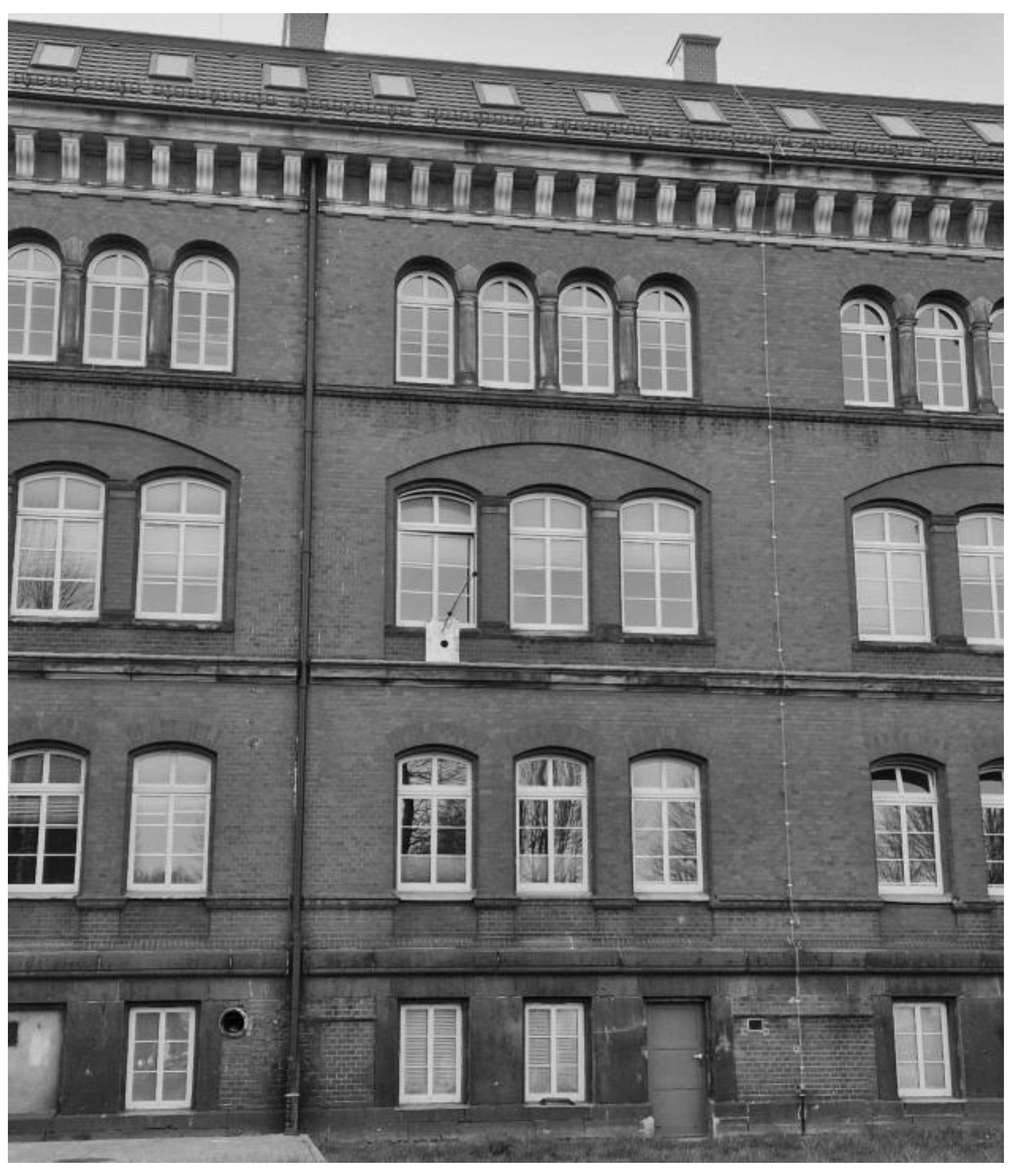

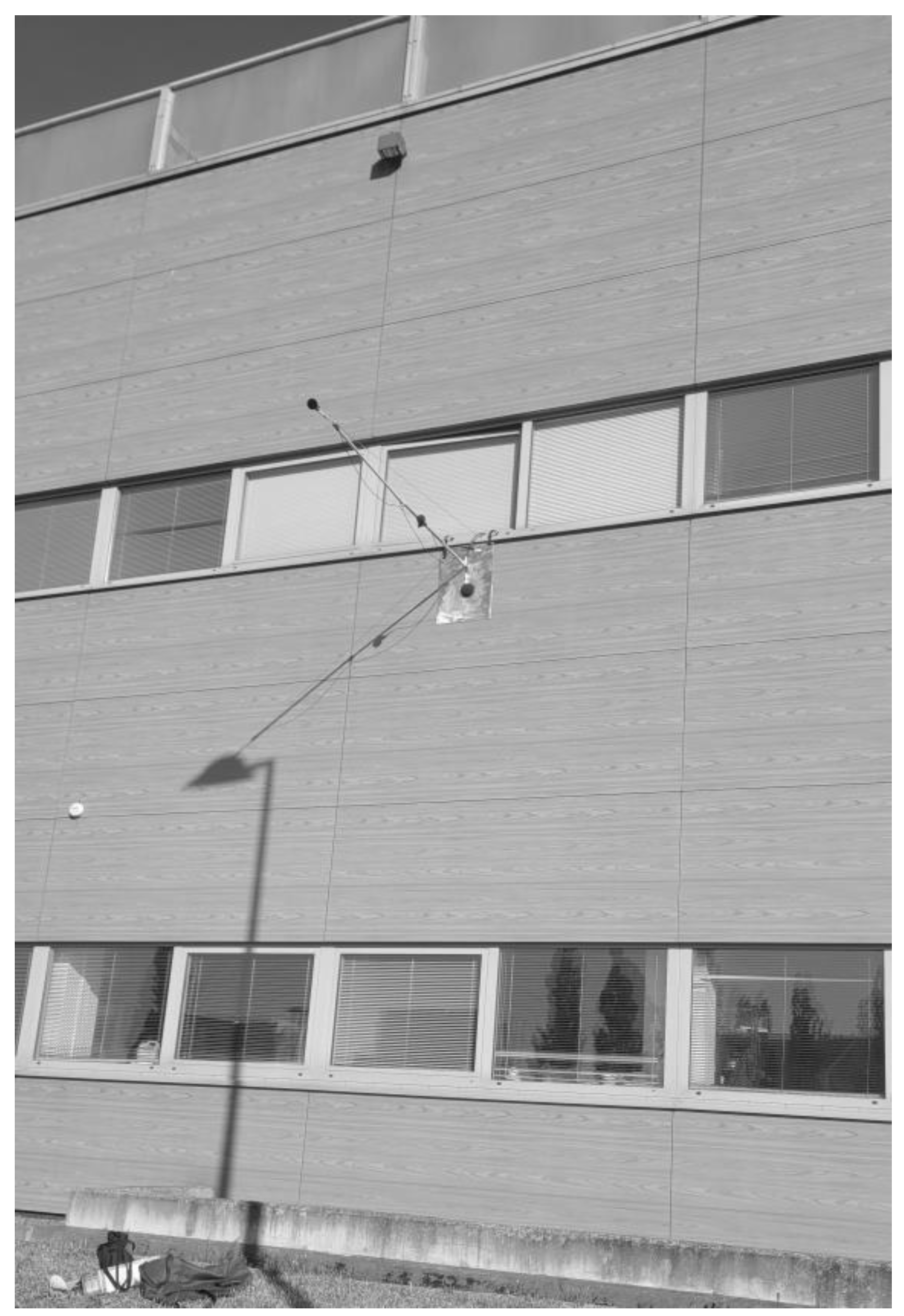
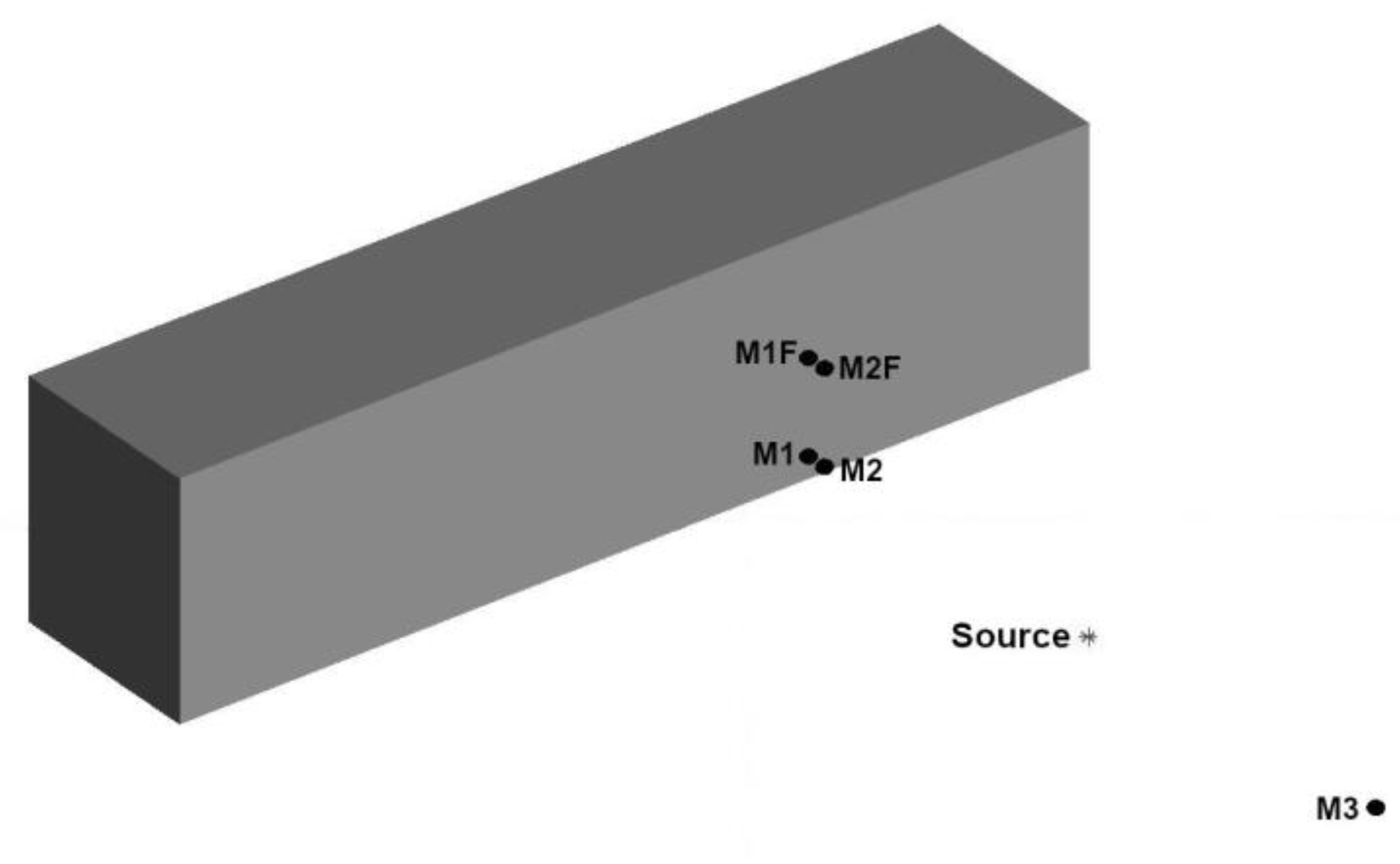
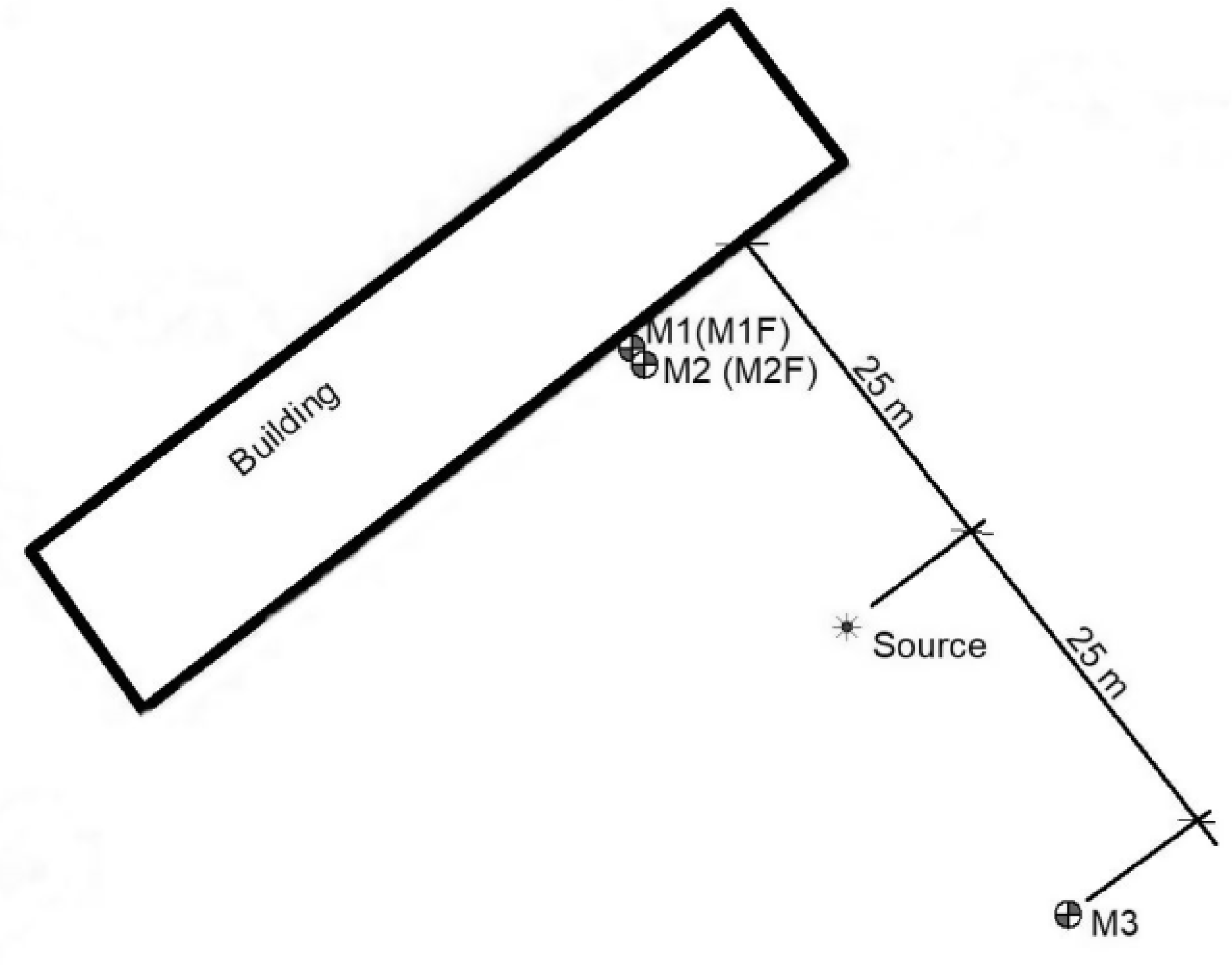
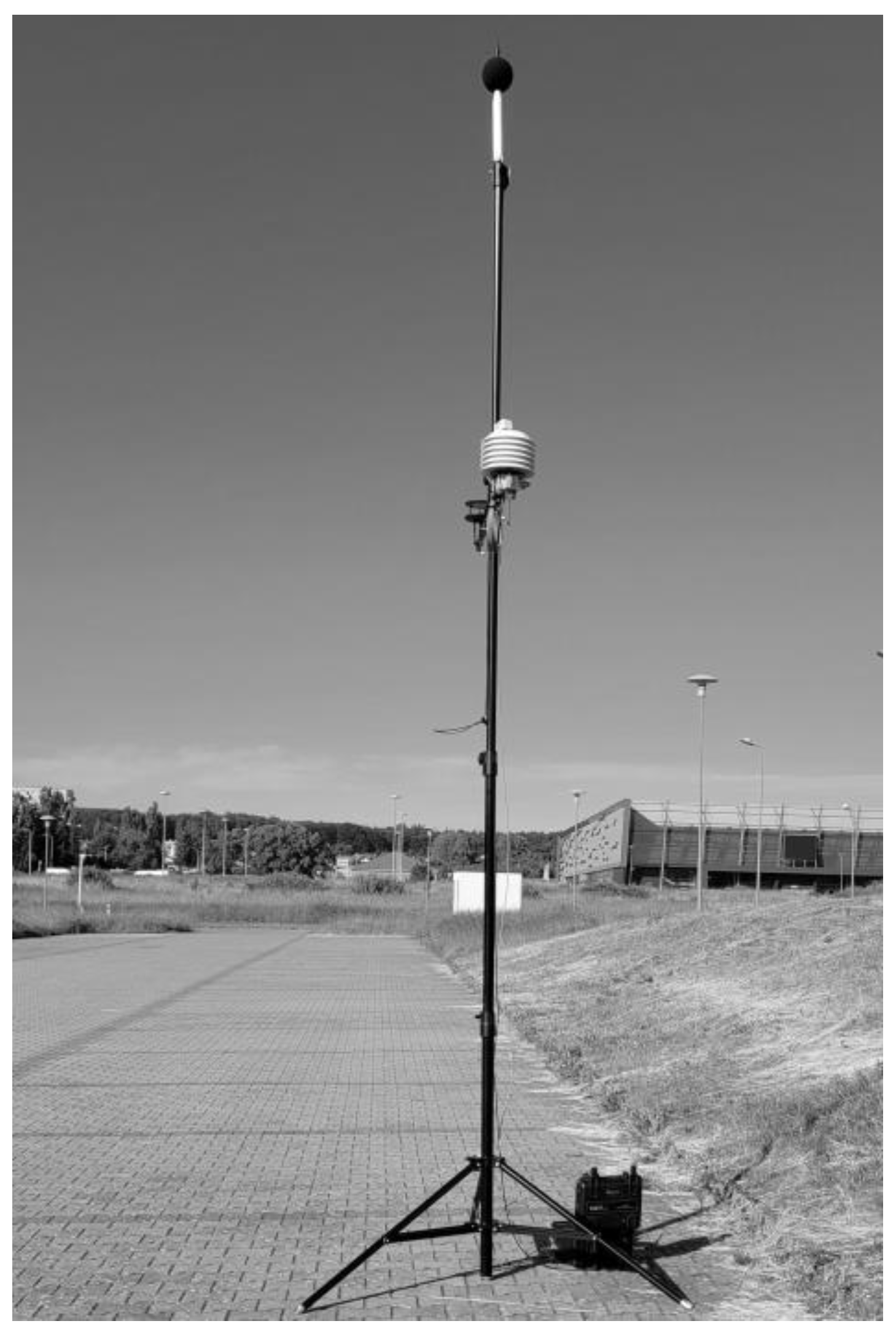

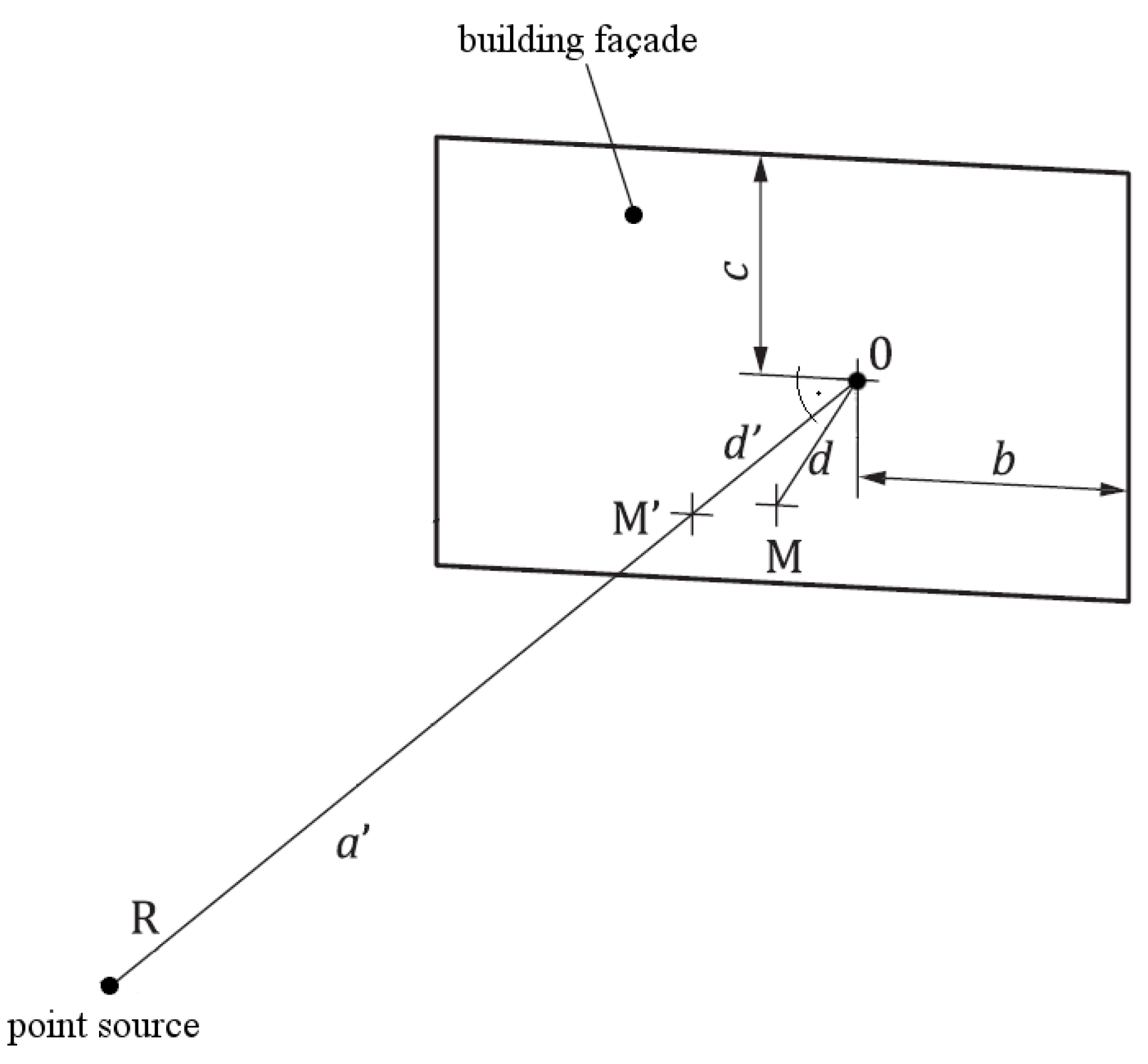
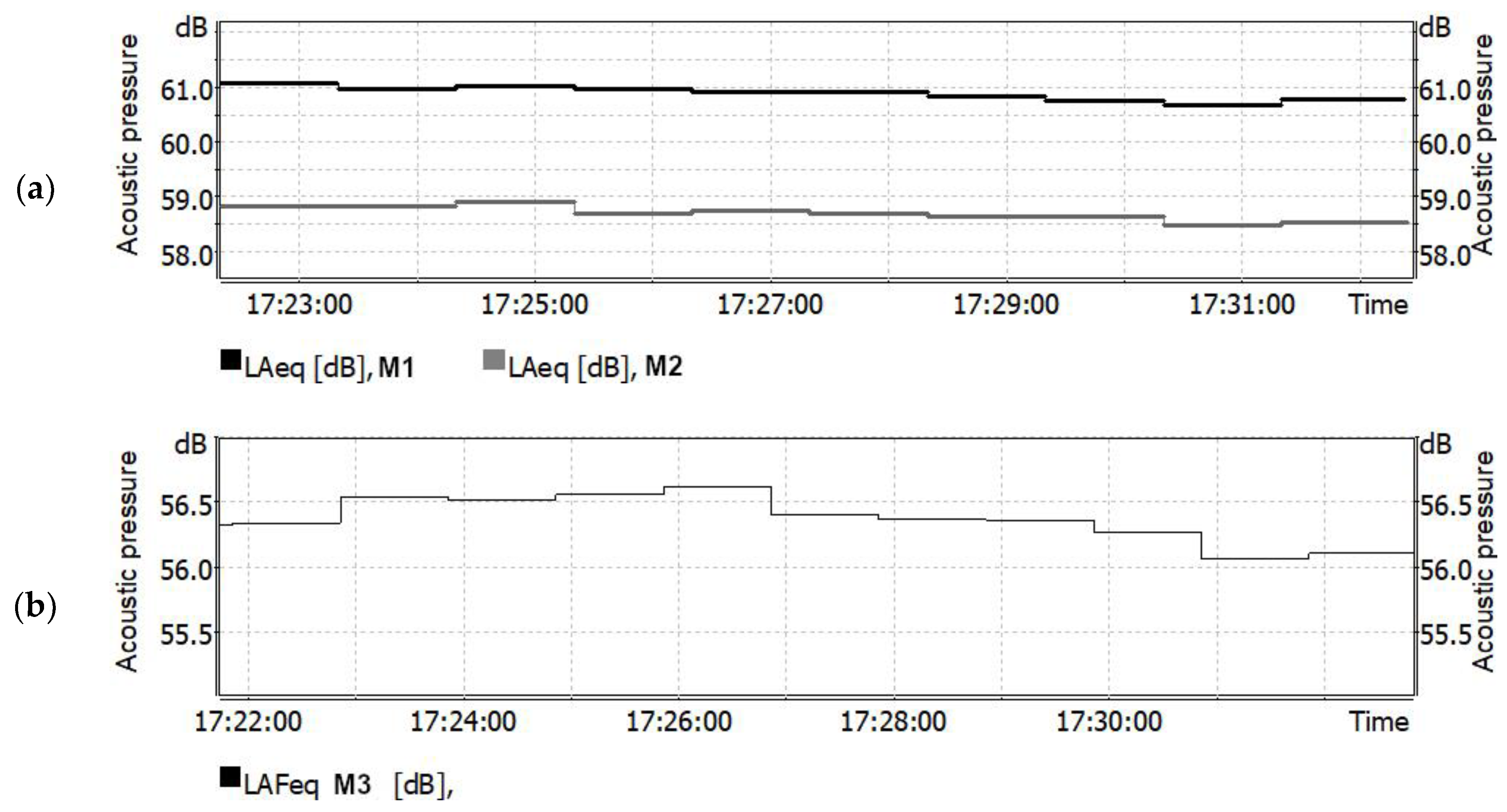


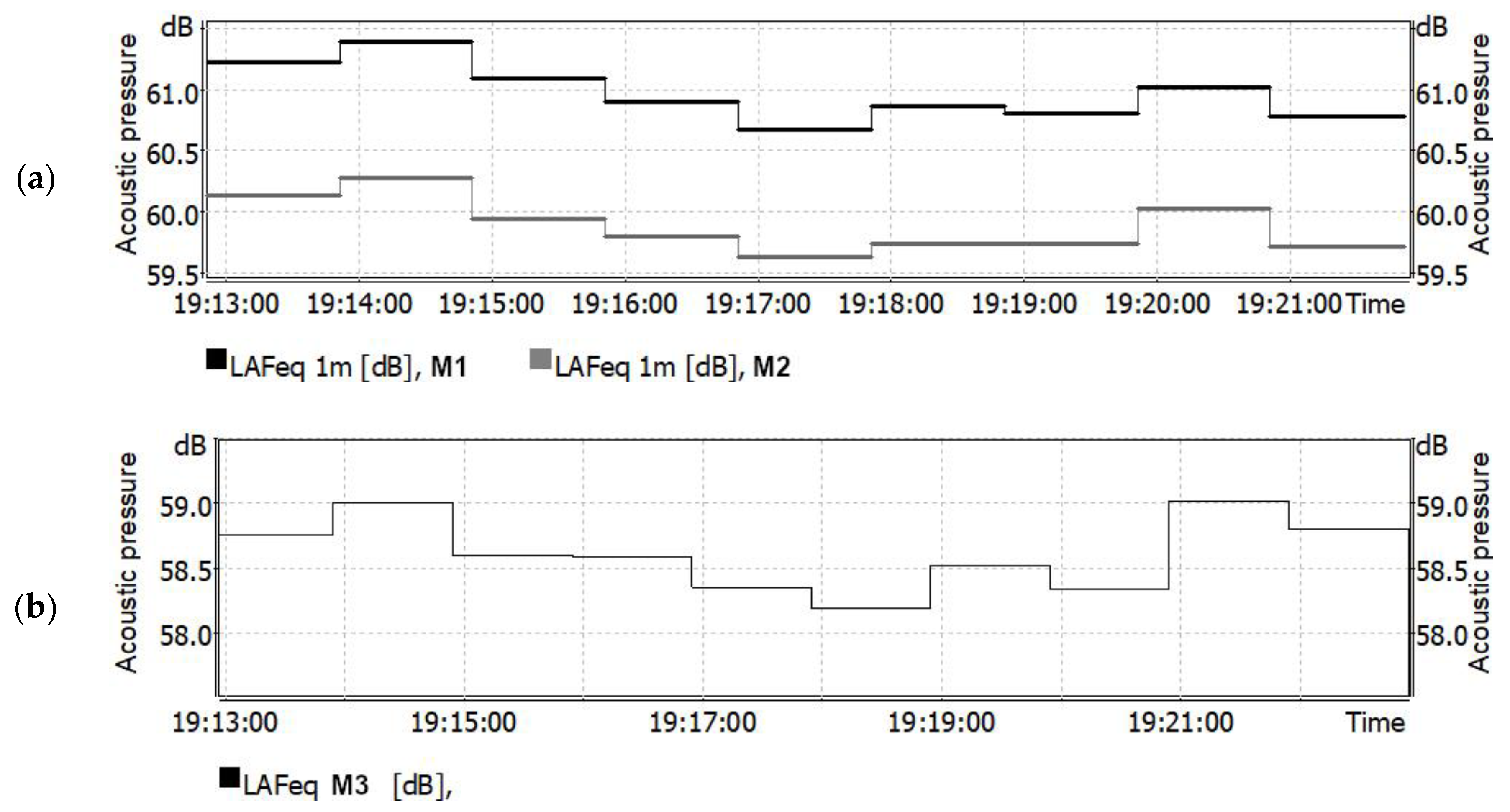
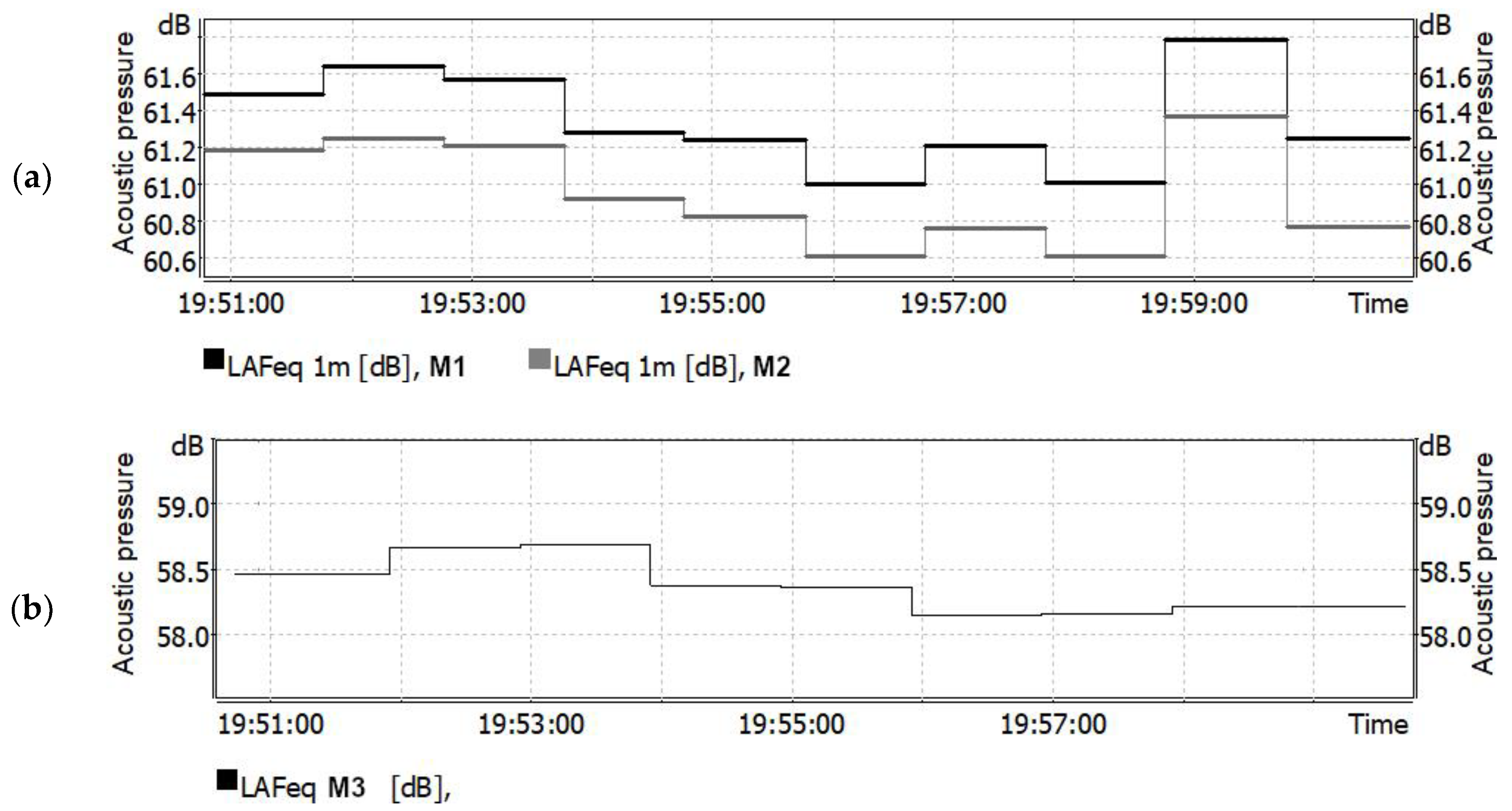
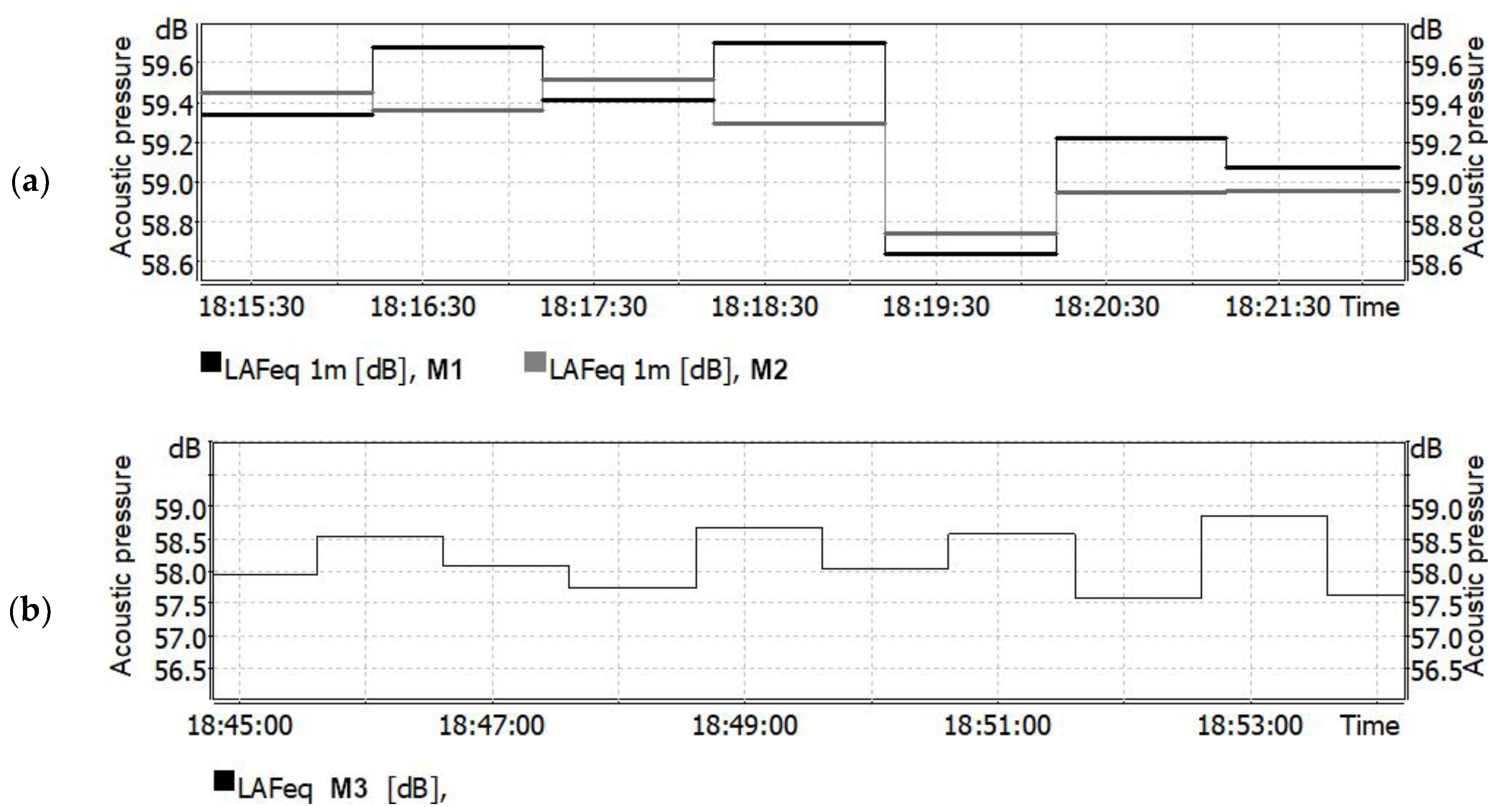
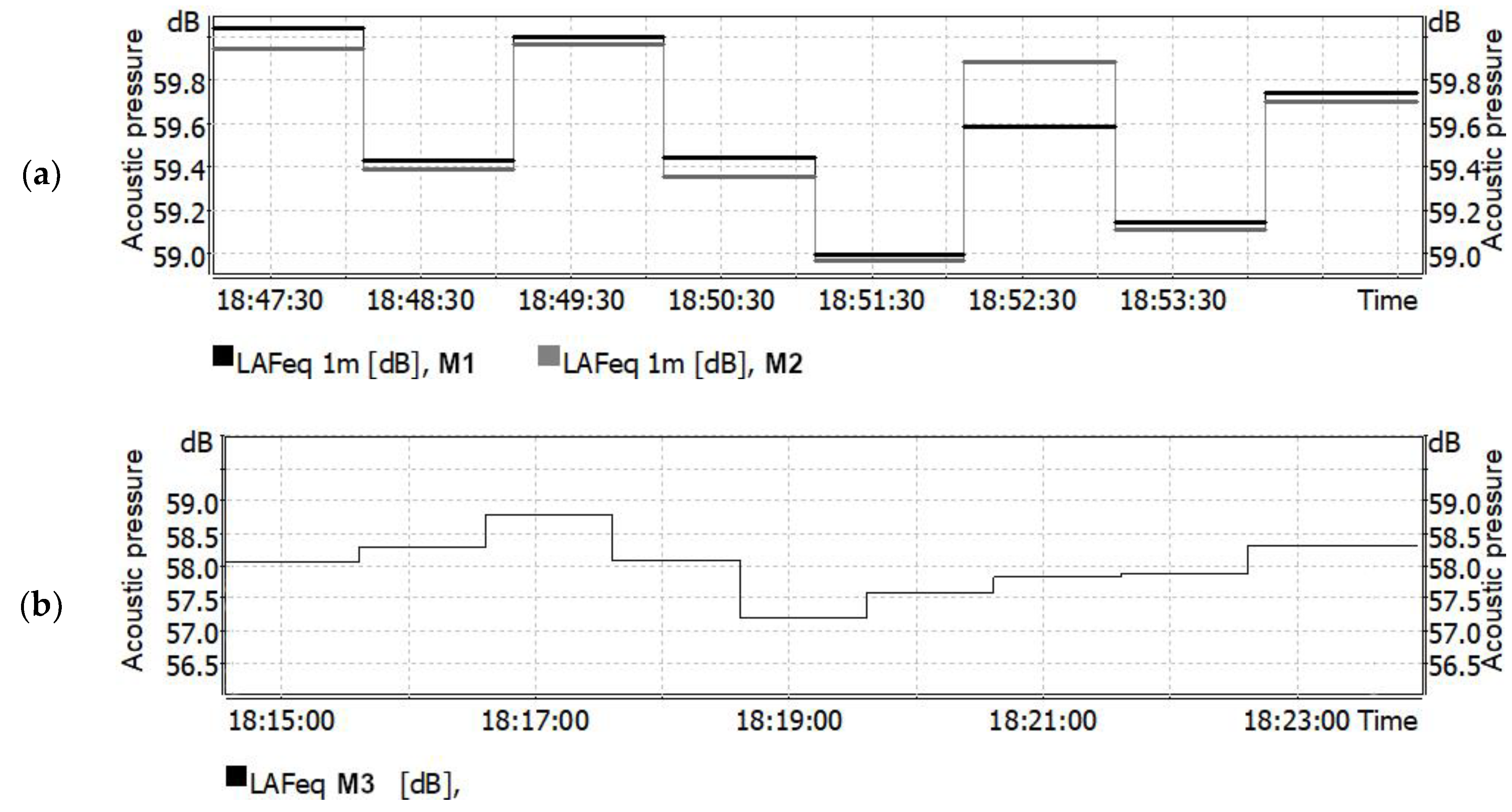
| Material | 125 Hz | 250 Hz | 500 Hz | 1 kHz | 2 kHz | 4 kHz |
|---|---|---|---|---|---|---|
| Brickwork, 10 mm flush pointing | 0.08 | 0.09 | 0.12 | 0.16 | 0.22 | 0.24 |
| Mineral plaster (rough finish) | 0.14 | 0.10 | 0.06 | 0.05 | 0.04 | 0.04 |
| Hard panels with smooth surface | 0.01 | 0.01 | 0.01 | 0.02 | 0.02 | 0.02 |
| Façade Type | Cycle Name | Height of Measurement at Elevation [m] | Parameters Measured in Each Cycle |
|---|---|---|---|
| A | A1 | 2 (M1 and M2) | LeqM1, LeqM2, LeqM3 |
| A2 | 6 (M1F and M2F) | ||
| B | B1 | 2 (M1 and M2) | |
| B2 | 6 (M1F and M2F) | ||
| C | C1 | 2 (M1 and M2) | |
| C2 | 6 (M1F and M2F) |
| Location Number | [dB] | [dB] | [dB] | [dB] |
|---|---|---|---|---|
| A1 | 60.3 | 58.7 | 57.0 | 57.5 |
| A2 | 58.3 | 58.2 | 56.8 | 57.1 |
| B1 | 61.0 | 59.9 | 58.6 | 59.2 |
| B2 | 61.3 | 61.0 | 58.6 | 58.8 |
| C1 | 59.3 | 59.1 | 58.0 | 58.5 |
| C2 | 59.6 | 59.4 | 58.1 | 58.4 |
| Location Number | |||
|---|---|---|---|
| Without Sound Source Normalization | With Sound Source Normalization | ||
| 1 | 2 | 3 | 4 |
| A1 | 1.6 ± 0.1 * | 3.3 ± 0.1 * | 2.8 ± 0.1 * |
| A2 | 0.1 ± 0.1 (n.s.) | 1.5 ± 0.3 * | 1.2 ± 0.3 * |
| B1 | 1.1 ± 0.1 * | 2.4 ± 0.1 * | 1.8 ± 0.1 * |
| B2 | 0.3 ± 0.1 * | 2.7 ± 0.1 * | 2.5 ± 0.1 * |
| C1 | 0.2 ± 0.2 (n.s.) | 1.3 ± 0.3 * | 0.8 ± 0.3 * |
| C2 | 0.2 ± 0.2 (n.s.) | 1.5 ± 0.5 * | 1.2 ± 0.5 * |
Disclaimer/Publisher’s Note: The statements, opinions and data contained in all publications are solely those of the individual author(s) and contributor(s) and not of MDPI and/or the editor(s). MDPI and/or the editor(s) disclaim responsibility for any injury to people or property resulting from any ideas, methods, instructions or products referred to in the content. |
© 2024 by the authors. Licensee MDPI, Basel, Switzerland. This article is an open access article distributed under the terms and conditions of the Creative Commons Attribution (CC BY) license (https://creativecommons.org/licenses/by/4.0/).
Share and Cite
Zagubień, A.; Wolniewicz, K. Measurements and Analysis of Sound Reflections from Selected Building Façades. Appl. Sci. 2024, 14, 11627. https://doi.org/10.3390/app142411627
Zagubień A, Wolniewicz K. Measurements and Analysis of Sound Reflections from Selected Building Façades. Applied Sciences. 2024; 14(24):11627. https://doi.org/10.3390/app142411627
Chicago/Turabian StyleZagubień, Adam, and Katarzyna Wolniewicz. 2024. "Measurements and Analysis of Sound Reflections from Selected Building Façades" Applied Sciences 14, no. 24: 11627. https://doi.org/10.3390/app142411627
APA StyleZagubień, A., & Wolniewicz, K. (2024). Measurements and Analysis of Sound Reflections from Selected Building Façades. Applied Sciences, 14(24), 11627. https://doi.org/10.3390/app142411627






